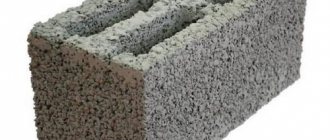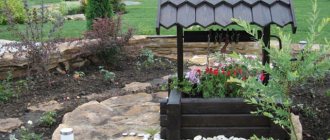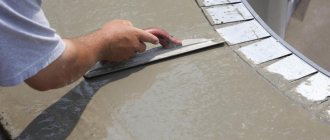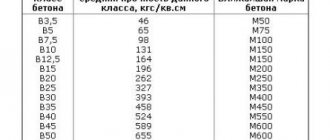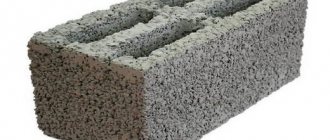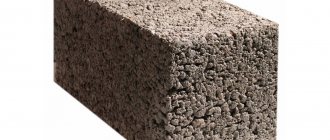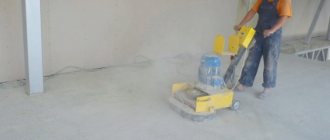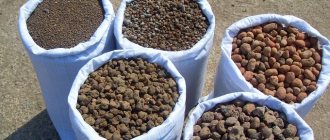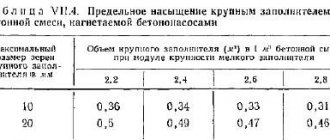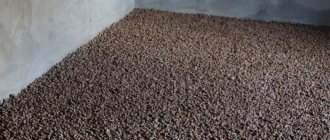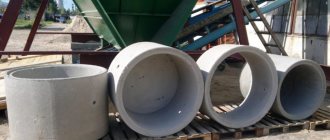(project of one of our customers - Artem, Tolyatti)
There comes a time in the life of almost every man when he thinks about building his own house.
And often in the conditions of such construction, two important points appear: the COST of construction, and THERMAL efficiency, on which the cost of operating the house in the future greatly depends.
After digging around the Internet, I came across a fairly old, but partly forgotten technology, which has recently begun to be widely used not only here, but also in the West.
The essence of the technology is simple - the base of the wall is monolithic expanded clay, which does not contain sand, and the expanded clay granules are coated with an adhesive cement composition. The advantages of this technology are that there remains empty air space between the granules, which, as is known, is the best heat insulator.
Expanded clay concrete as an inexpensive building material and its advantages
Expanded clay concrete is a concrete structure, lightweight with expanded clay filler, which in turn is naturally plasticized clay foamed during firing. The production technology is quite simple and has been known for a very long time. This is an inexpensive, heat-intensive and environmentally friendly material that significantly exceeds the properties of ordinary clay. The walls are characterized by good wear resistance and strength.
Thus, the use of expanded clay as a filler in the construction of individual houses allows not only to lighten the structure, but also to significantly improve its characteristics. The erected walls turn out to be light, durable and warm; additional insulation with polystyrene foam on both sides makes it possible to simplify the finishing and carry out additional insulation with the “dew point” moving beyond the boundaries of the house wall. This design will be practically “eternal” and, most importantly, inexpensive.
Advantages of expanded clay concrete produced according to GOST:
- surpasses other “light” concretes in heat and sound insulation by approximately 1.5 times;
- has good frost resistance;
- chemically and moisture resistant;
- has a lower price;
- the mass of blocks or composition based on expanded clay concrete is 1.5 times less (the specific gravity of the block is 2.5 times less than that of brick);
- the speed of wall construction is 4–5 times higher than with conventional building materials;
- a lightweight strip foundation is required;
- ensures a reduction in heat loss during operation by 75%;
- can be used in cold and warm climate zones;
- does not require maintenance and is durable;
- unlikely shrinkage due to the low weight of the structure;
- Expanded clay concrete does not burn.
Advice: if you want to build an inexpensive box for an individual home over the summer at minimal cost, take a closer look at expanded clay concrete.
Casting the walls of a house with monolithic expanded clay concrete. Theory and experimental work.
Unfortunately, I was unable to find detailed instructions on the Internet on how to make expanded clay concrete myself. So, whatever you do once, do it twice... Everyone writes only about its advantages.
Although it is intuitively clear that since expanded clay acts as a filler in ordinary concrete (instead of crushed stone), then the technology should be approximately the same.
Meanwhile, even expanded clay concrete can also be load-bearing (obviously with the absolute filling of the space between the expanded clay granules with a solution). And there are also easy ones - i.e. with additional voids between expanded clay granules. This makes expanded clay concrete an even more heat-saving material.
The expanded clay granule is covered on the outside with a fairly strong and smooth crust of sintered clay. This causes very low moisture absorption of expanded clay, only 3-5% (unlike foam concrete and aerated concrete, which absorb water like a sponge).
From here, of course, the simple conclusion follows that expanded clay concrete ideally consists of expanded clay granules packed as densely as possible, each of which is lubricated with cement mortar and glued to other granules.
It is obvious that the technology for manufacturing expanded clay concrete is conventional concrete. It is necessary to prepare a liquid solution and pour expanded clay into it (with vigorous stirring). Moreover, it is necessary to strive to ensure that literally every granule of expanded clay is transported in solution. After which the mixture is laid out in a mold and lightly compacted, being careful not to damage the expanded clay granules.
The ratio of the amount of solution and granules determines the brand of expanded clay concrete. If there is excess solution, it will fill all the space between the granules. Expanded clay concrete will be load-bearing, colder but more durable. If the solution is insufficient, voids will remain between the granules. Expanded clay concrete will be lighter and warmer, but less durable.
While scouring the Internet, I found an interesting patent for a method for making expanded clay concrete. It recommends not pouring expanded clay into the solution, but adding cement to wet expanded clay. Judge for yourself:
———
The method for producing porous expanded clay concrete relates to the production of building materials, mainly to the production of structural and thermal insulation material for enclosing structures. The technical result is the production of a building material with high thermal insulation properties and low cost. The method involves mixing dosed amounts of water, cement and expanded clay to a homogeneous consistency, and first, large expanded clay granules of a fraction of 20-40 mm are screened out, after which a dosed amount of large granules of the specified fraction and water is fed into a concrete mixer and mixed for no more than 0.5 minutes , then a dosed amount of cement is fed into the concrete mixer and the concrete mixture is finally mixed to a homogeneous consistency for no more than 0.5 minutes at the following component consumption per 1 m3 of concrete: cement 65-85 kg, expanded clay fraction 20-40 mm 400-500 kg , water 30-40 l.
——-
As you understand, such expanded clay has practically no filling between the granules. Expanded clay granules are only glued to each other by cement at the points where they touch. The consumption of materials (cement, in particular) is extremely small (for 1 cubic meter of expanded clay concrete - only 1.5 bags!). Such expanded clay concrete will be very warm.
However, the strength characteristics of such expanded clay concrete are not given. We will have to conduct tests during the casting of the walls. Yes, and obviously you will have to tinker first and carefully select the ratio of expanded clay concrete components. Perhaps, due to the insignificant consumption of cement, add glue to it for gluing ceramic tiles or natural stone. Its price is slightly higher than the price of cement, but its adhesive properties (and here they are important) are an order of magnitude higher than cement ones.
Immediately after the delivery of expanded clay, I decided to slightly test the future technology. It was already a rainy autumn and it made no sense to start casting the walls before winter. But I really wanted to try.
The actual technology for casting expanded clay concrete walls using adjustable formwork is quite simple. The formwork is installed in the desired location and filled with expanded clay concrete mixture. After a couple of days, when the expanded clay concrete has set securely, the formwork is rearranged, i.e. move it one block (step) and fill it with the mixture again. And so on.
Of course, work is carried out not with one set of formwork, but with 10-15-20 or more. Starting to cast walls in different places at once, they are cast in several tiers, shifted by half a body. Therefore, the work is not much slower than laying expanded clay concrete blocks.
I was able to conduct small tests of this technology. True, I did not cast a block, but sealed the opening between the concrete floor slabs. But the essence is the same. At the same time, I also tested a model of the future adjustable formwork.
The formwork walls were made of waste boards nailed together into a shield. (Of course, the actual formwork will be made of moisture-resistant plywood or metal). To prevent the edges of the formwork from bursting with mortar, they are tightened with threaded steel studs. And so that the pins themselves do not remain forever in the solution, they are covered with pieces of an old corrugated plastic hose. (In the future, I plan to use corrugated cable duct. It is sold in coils of 50-100 meters and is very cheap).
Of course, after casting there will be several through holes left in the block. However, I consider this more of a plus than a minus. Sealing them is not difficult at all, for example using polyurethane foam. But if necessary, you will not need to drill a hole in the wall for communications. And there will be no problems with rigging work if the block happens to be cast not directly into the wall, but separately. Pins are inserted into the holes, using which you can move the block.
After installing the formwork in place, I filled it with expanded clay concrete mixture and lightly compacted the mixture. In this case, I did not try to maintain any proportions between expanded clay and mortar. The solution was in obvious excess, so the expanded clay concrete turned out to be load-bearing and heavy. Well, in this place, in fact, this is what is needed - the level of the concrete floor slabs of the basement.
After a couple of days, I unscrewed the nuts on the studs and removed the studs themselves without difficulty. Then he removed the formwork. Well, overall I was pleased with the results. Expanded clay concrete turned out normal. Since the outside of the house is supposed to be plastered, the space between the expanded clay granules will serve as an excellent hook for plaster.
This simple experience finally convinced me of choosing expanded clay as a material for building the walls of a house. In addition, with this technology it will not be difficult to introduce polystyrene (foam) into the expanded clay concrete as an additional insulation material. For example, in the form of small balls or slabs. As well as reinforcement for the wall’s load-bearing frame.
Removable and permanent formwork for expanded clay concrete
Removable formwork is a structure used to fill walls with concrete mortar, in our case expanded clay concrete. The permanent formwork version is most often made of polystyrene foam and is equipped with reinforcing elements that hold the structure during construction work. The formation of the walls of the house in this case is simplified as much as possible; they are assembled like a constructor - in the form of a permanent block of hollow polystyrene, which is filled with the prepared solution. Of course, it is necessary to use reinforcing bars to reinforce the wall structure.
Despite the increase in the cost of building a house due to the use of polystyrene molds as a limiter, the labor intensity of the work is simplified as much as possible. Only two people without qualifications can build such a house with their own hands. In addition, there is no need for additional heating.
During operation, you will certainly notice a difference in energy costs for heating your home. Individual houses made of expanded clay concrete can rightfully be called “passive”, that is, they do not require strong heating. Warm floors can be used as a heating system. To protect walls from rodents, special protective compounds are used, and all openings through which mice can enter the space between the walls are protected as much as possible.
The use of expanded polystyrene to build a house made of expanded clay concrete has its positive and negative features. It should be noted that the vapor permeability of this material is somewhat less, so for insulation it is recommended not foam plastic, but mineral wool. However, if you still use this option, provide additional micro-ventilation of the premises.
DIY house made of monolithic expanded clay concrete
Almost anyone with basic skills in handling certain tools can build a house with their own hands from monolithic expanded clay concrete. What is the essence of such a house? One or another form of formwork is built, a solution based on expanded clay and cement is prepared and poured into this formwork. The resulting structure dries for some time and becomes ready for use.
How to build expanded clay concrete walls
Foundation. A strip foundation is also suitable for monolithic walls made of expanded clay concrete, since the load will be relatively low. But the width of the foundation must be large enough, and the insulation (several layers of roofing material) must be reliable. Formwork. The formwork can be made from either wood or not very durable material (plywood, polystyrene foam, etc.). Expanded clay concrete does not create much pressure, so the requirements for structural strength are small.
The formwork is mainly made portable, for several meters. In this case, the walls are erected in stages, in parts of a certain length.
Another way to use monolithic expanded clay concrete is multilayer. Two walls are built, for example, from brick, a gap is left between them, into which expanded clay concrete is poured.
Mortar components, fittings and equipment. To obtain expanded clay concrete, you need expanded clay gravel itself, preferably large fractions, expanded clay sand, cement, water and some additives. Standard composition of the solution: expanded clay – 40 parts; cement - 7 parts; water – 4-5 parts; additives, such as liquid soap.
To mix the solution, a concrete mixer with forced mixing using blades or a mixer-capsulator is useful. When pouring, fiberglass reinforcement should be used where necessary.
Filling. The solution is mixed and placed in the formwork. Laying is done in layers of 20-30 cm. In the case of using coarse expanded clay, careful compaction is necessary using external vibrators.
After filling is completed, the walls must be allowed to dry.
Technology of a monolithic house made of expanded clay concrete
The technology of a monolithic house made of expanded clay concrete includes the following stages of construction. Fulfilling technological requirements will not be difficult either if you decide to do everything yourself. The walls are assembled as in a children's construction set; the boundary blocks are filled with the selected solution. In our case, it is a mortar made of expanded clay concrete.
Initially, you will need to make a foundation; for these purposes, a strip version with a slight depth is quite suitable, since the structure will only slightly exceed the weight of the version of a frame or wooden house. Because of this, the labor intensity of the work is much less, this is especially important if you build the box with your own hands. Obviously, any foundation has a reinforcing belt; also, when laying the mortar, it is necessary to provide for the installation of vertical rods that will firmly connect the walls to the foundation. Please also note that polystyrene foam blocks may be larger than the thickness of the foundation for the thickness of the insulation. This is done so that you can seal and insulate the foundation. This is a prerequisite for the walls and foundations of energy-efficient houses.
Foundation for a house made of poured expanded clay concrete
The construction of a foundation made of expanded clay concrete for an ordinary individual house can be carried out according to the above scheme. As you can see, the sand and gravel base will be 30 cm, the strip foundation is made 60 cm high, of which 10 cm is above the ground surface. If you want to raise the house with a foundation to insulate the floors, this can be done to the height you choose. Typically this height is 30-50 cm. The above option is sufficient for light walls filled with expanded clay.
If necessary, the foundation for an expanded clay concrete house can be made of concrete slabs. This will significantly reduce construction time, but will require the use of special equipment.
You might be interested
Floor insulation with expanded clay How to insulate a floor with expanded clay in a private house on the ground floor or in the attic? What if the floor in a bathhouse or garage is insulated? The technology of floor insulation with expanded clay is available to everyone, it is simple and effective.
Projects of houses made from expanded clay concrete blocks Expanded clay concrete blocks are an excellent material for building a warm and cozy home. A variety of ready-made house designs made from expanded clay concrete blocks. We even offer free projects of various configurations.
Expanded clay concrete in construction Popular in other countries, expanded clay concrete is gradually proving all its advantages to our consumers.
Application in construction.
According to their properties, ceramics...
